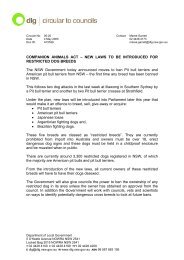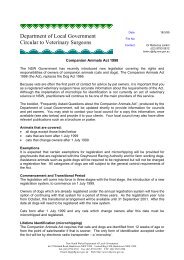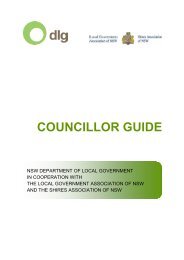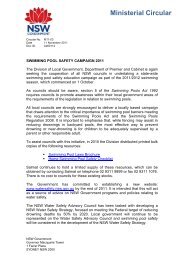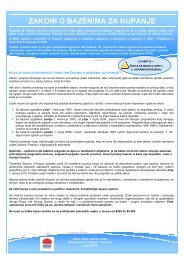Practice Note No. 15 - Water Safety - Division of Local Government ...
Practice Note No. 15 - Water Safety - Division of Local Government ...
Practice Note No. 15 - Water Safety - Division of Local Government ...
You also want an ePaper? Increase the reach of your titles
YUMPU automatically turns print PDFs into web optimized ePapers that Google loves.
Swimming pools with single sex change rooms onlyWhere swimming pools have single sex change rooms only, consideration should be given to the followingoptions:Øconstruction <strong>of</strong> a new change room(s) for use by familiesØmodification <strong>of</strong> existing facilities to provide a change room(s) for use by familiesØallocation <strong>of</strong> a lockable cubicle(s) within single sex change rooms for use by children <strong>of</strong> the oppositesex and their parent. This should be located near the entrance to the change rooms so as to minimiseany adverse impact on other patronsØdevelopment <strong>of</strong> a policy regarding children using change rooms for the opposite sex (see sectionbelow on development <strong>of</strong> a council policy)Development <strong>of</strong> a council policyUnder Ordinance <strong>No</strong>.52 <strong>of</strong> the former <strong>Local</strong> <strong>Government</strong> Act 1919, the maximum age at which childrencould be taken into a change room used by the opposite sex was eight years. This provision does not existunder the current <strong>Local</strong> <strong>Government</strong> Act 1993. Therefore, this is a matter for council discretion.Different policies have developed among councils throughout NSW in relation to this issue. Informationprovided by a sample <strong>of</strong> councils showed that the maximum age permitted to use change rooms for theopposite sex ranged from 4 years, or up to school age, to seven or eight years. The Aquatic and RecreationInstitute recommends that children aged seven years and under be allowed to use change rooms for theopposite sex. While in some cases, this information was displayed on signs, in many cases patrons onlybecome aware <strong>of</strong> the policy after a complaint had been made to pool staff by another patron.<strong>Practice</strong> <strong><strong>No</strong>te</strong> <strong>15</strong>: <strong>Water</strong> <strong>Safety</strong>Councils are therefore encouraged to develop a policy concerning the use <strong>of</strong> change rooms by children <strong>of</strong>the opposite sex. In developing such a policy, an appropriate balance between the right <strong>of</strong> children to besafe and the right <strong>of</strong> swimming pool patrons to privacy when changing needs to be achieved. It is importantthat the policy be developed in consultation with patrons. Particular attention should be given to consultingwith patrons from non-English speaking backgrounds in a culturally appropriate way.The policy might provide for the following:ØØa maximum age for children to use change rooms for the opposite sexallocation <strong>of</strong> a lockable cubicle(s) within single sex change rooms for use by children <strong>of</strong> the oppositesex and their parent20





